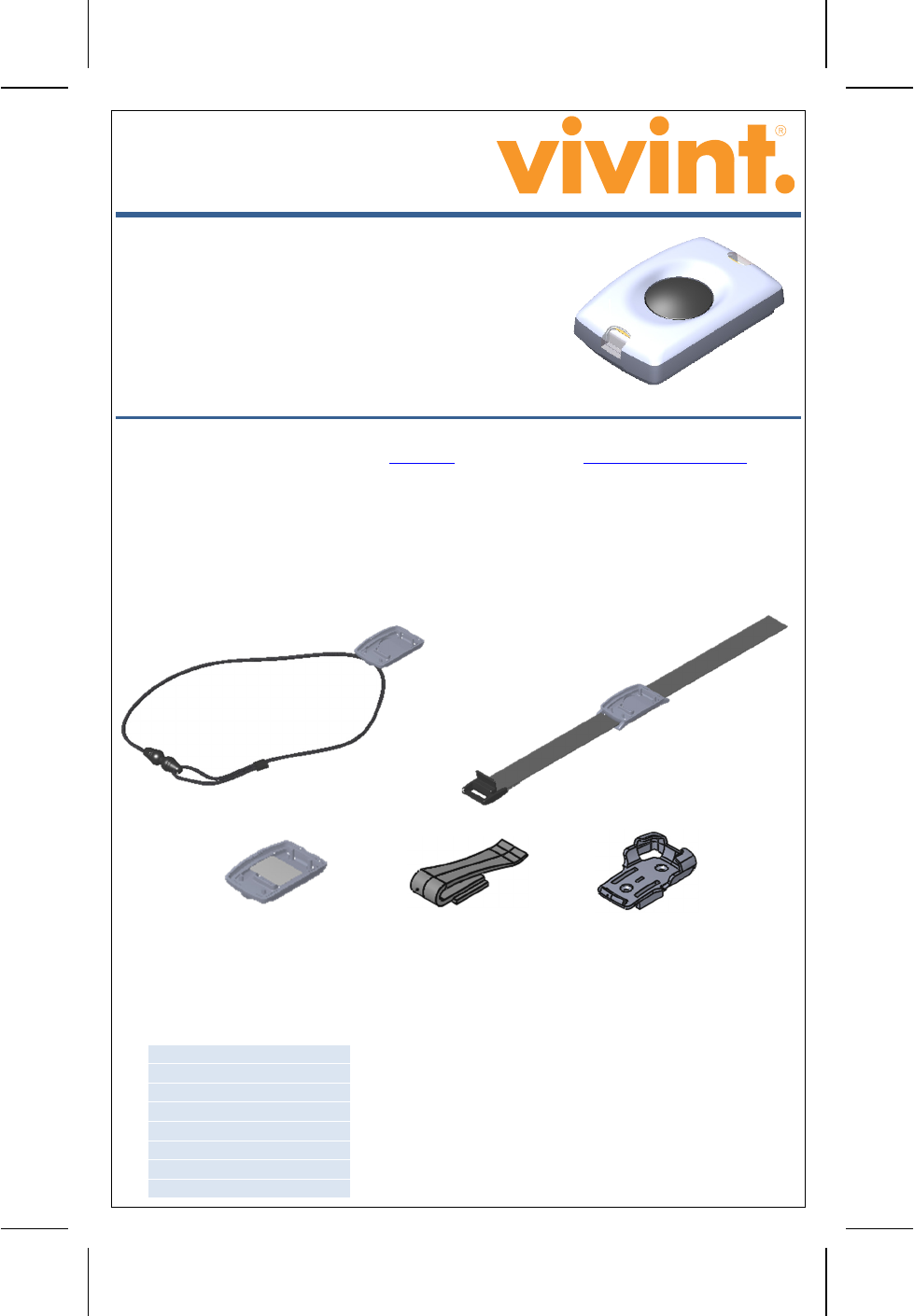Vivint PB01 Personal Emergency Indicator User Manual
Vivint. Inc. Personal Emergency Indicator Users Manual
Vivint >
Users Manual

Panic Button Remote
(V-PANIC2-345)
Quick Reference
Programming Instructions
(F
or more details, go to the Support page at: Vivint.com, and the KIM site at: corp.vivint.com/sites/KIM/)
• The PANIC2 device can be programmed as a supervised or non-supervised device. If supervised, the
device should always stay within range of the panel.
• The device can be programmed to contact emergency services with either an audible or silent alarm.
Installer Test
Press and hold the button for 2 seconds to send signals from the device to the control panel.
Specifications
Wireless Signal Range
300 feet (91.4 m), open air
Battery
Panasonic CR2032 or equivalent lithium battery
Battery Life
3-5 years under normal usage
Transmitter Frequency
345 MHz
Code Outputs
Alarm, Alarm Restore, Supervisory, Low Battery
Supervisory Interval
70 minutes per signal (12 hours for panel to report supervision failure)
Operating Temperature Limits
32° to 120°F (0° to 49°C)
Relative Humidity
5-95% Non-Condensing
PRINT INSTRUCTIONS: REFERENCE SHEET V-PANIC2-345 P/N 77-000020-001 REV 1.1 |
INK:
BLACK | MATERIAL: 20 LB MEAD BOND | SIZE: 5.50" X 8.50" SCALE 1:1 |
FOLD
S: TRI-FOLD VERTICAL, TRI-FOLD HORIZONTAL (TO FIT IN BOX)
T
he Vivint Panic Button Remote (PANIC2) is designed to transmit an
emergency signal
from any location within range of the control panel.
T
he panel will receive signals whether the system is armed or disarmed.
The PANIC2
device is discrete and versatile. It is small and lightweight
enough to be stored in a pocket or purse.
Additionally, the supplied
accessories allow the
device to be worn on a lanyard, wristband, or belt
clip
/holder; or placed in the holder that can be mounted in a fixed
location
(see accessory drawings).
Accessories
Use the supplied accessories
to carry or mount the PANIC2 device.

Battery Installation
The battery should last 3
-5 years under normal use. If the battery is low, a low battery
notification will be indicated on the control panel.
To replace the battery,
1. Remove the cover by inserting a coin in the slot and twisting gently.
2. Place a small flathead screwdriver in the slot between the metal clip and battery
and pry the battery up and out of the battery holder.
3. Insert the replacement battery with the + sign facing out.*
4. Replace the sensor cover.
5. Verify the device is functioning properly.
*The battery may fit loose in the battery holder, but the cover will hold it securely in place.
FCC and Industry Canada Regulatory Declarations*
CAUTION:
Unauthorized changes or modifications could void the user’s authority to operate the equipment.
This device has been tested and found to comply with the limits for a Class B digital device, pursuant to Part 15 of FCC Rule
s and Industry Canada (IC)
license
-exempt RSS standard(s). Operation is subject to the following two conditions:
(1) This device may not cause harmful interference, and
(2) This device must accept any interference received, including interference that may cause undesired operation of the device.
These limits are designed to pr
ovide reasonable protection against harmful interference in a residential installation. This equipment generates, uses,
and can radiate radio frequency energy and
, if not installed and used in accordance with the instructions, may cause harmful interference to radio
communications. However, there is no guarantee that interference will not occur in a particular installation. If this equipme
nt does cause harmful
inter
ference to radio or television reception, which can be determined by turning the equipment off and on, the user is encouraged to try to correct
the interference by one or more of the following measures:
• Reorient or relocate the receiving antenna.
• Increase the separation between the equipment and the receiver.
• Connect the equipment into an outlet on a circuit different from that to which the receiver is connected.
• Consult the dealer or an experienced radio/television technician for help.
PRUDENCE
: Changements ou modifications pourraient annuler le droit de l'utilisateur à utiliser l'équipement non autorisées.
Conformément à la réglementation d'Industrie Canada, le présent émetteur radio peut fonctionner avec une antenne d'un type et
d'un gain maximal
(ou
inférieur) approuvé pour l'émetteur par Industrie Canada. Dans le but de réduire les risques de brouillage radioélectrique à l'intention des autres
utilisateurs, il faut choisir le type d'antenne et son gain de sorte que la puissance isotrope rayonnée équi
valente (p.i.r.e.) ne dépasse pas l'intensité
nécessaire à l'établissement d'une communication satisfaisante.
Le présent appareil est conforme aux CNR d’Industrie Canada applicables aux appareils radio exempts de licence. L’exploitatio
n est autorisée aux d
eux
conditions suivantes: (1) l’appareil ne doit pas produire de brouillage, et (2) l’utilisateur de l’appareil doit accepter tou
t brouillage radioélectrique subi,
même si le brouillage est susceptible d’en compromettre le fonctionnement.
Ces limites sont
conçues pour fournir une protection raisonnable contre les interférences nuisibles dans une installation résidentielle. Cet é
quipement
génère, utilise et peut émettre une énergie de radiofréquence et, s'il n'est pas installé et utilisé conformément aux ins
tructions, il peut causer des
interférences nuisibles aux communications radio. Cependant, il n'existe aucune garantie que des interférences no se produiro
nt pas dans une
installation particulière. Si cet équipement provoque des interférences nuisibles à l
a réception radio ou télévision, ce qui peut être déterminé en
mettant l'équipement hors et sous tension, l'utilisateur est encouragé à essayer de corriger l'interférence par une ou plusieurs des mesures suivantes:
• Réorienter ou déplacer l'antenne de réception.
• Augmentez la distance entre l'équipement et le récepteur.
• Connecter l'équipement à une sortie sur un circuit différent de celui sur lequel le récepteur est branché.
• Consulter le revendeur ou un technicien radio / télévision expérimenté pour de l'aide.
FCC ID:
2AAAS-PB01 , IC ID: 10941A-PB01
*For more compliance and warranty information, visit:
www.vivint.com
WARNING! The polarity of the battery must be observed (as shown in the image). Improper handling of lithium batteries may result
in heat generation, explosion, or fire, which may lead to personal injury. Replace only with the same or equivalent battery type as
recommended by the manufacturer.
AVERTISSEMENT! La polarité de la batterie doit être observée (comme indiqué dans l'image). Une mauvaise manipulation des piles
au lithium peut conduire à la production de chaleur, une explosion ou un incendie, ce qui peut entraîner des blessures. Remplacez-le
par le même type ou équivalent de la batterie tel que recommandé par le fabricant.
Batteries must not be recharged, disassembled or disposed of
in fire. Disposal of used batteries must be made in accordance with the waste
recovery and recycling regulations in your area.
Keep away from small children. If batteries are swallowed,
promptly see a doctor.
California Only:
This Perchlorate warning applies ONLY to Manganese Dioxide Lithium cells sold or distributed in California, USA. Perchlorate material
special handling may apply.
(For more information, visit: www.dtsc.ca.gov/hazardouswaste/perchlorate)
© 2014 Vivint Inc. All Rights Reserved. | www.vivint.com | M/N: PB01 | Doc P/N: 77-000020-001 Rev. 1.1
Wireless Product Notice
Wireless communications hardware provides reliable communication;
however, there are limitations which must be observed.
• The transmitters are required to comply with all applicable wireless rules and regulations. As such, they have limited
transmitter power and limited range.
• Wireless signals may be blocked by radio signals that occur on or near the wireless operating frequencies.